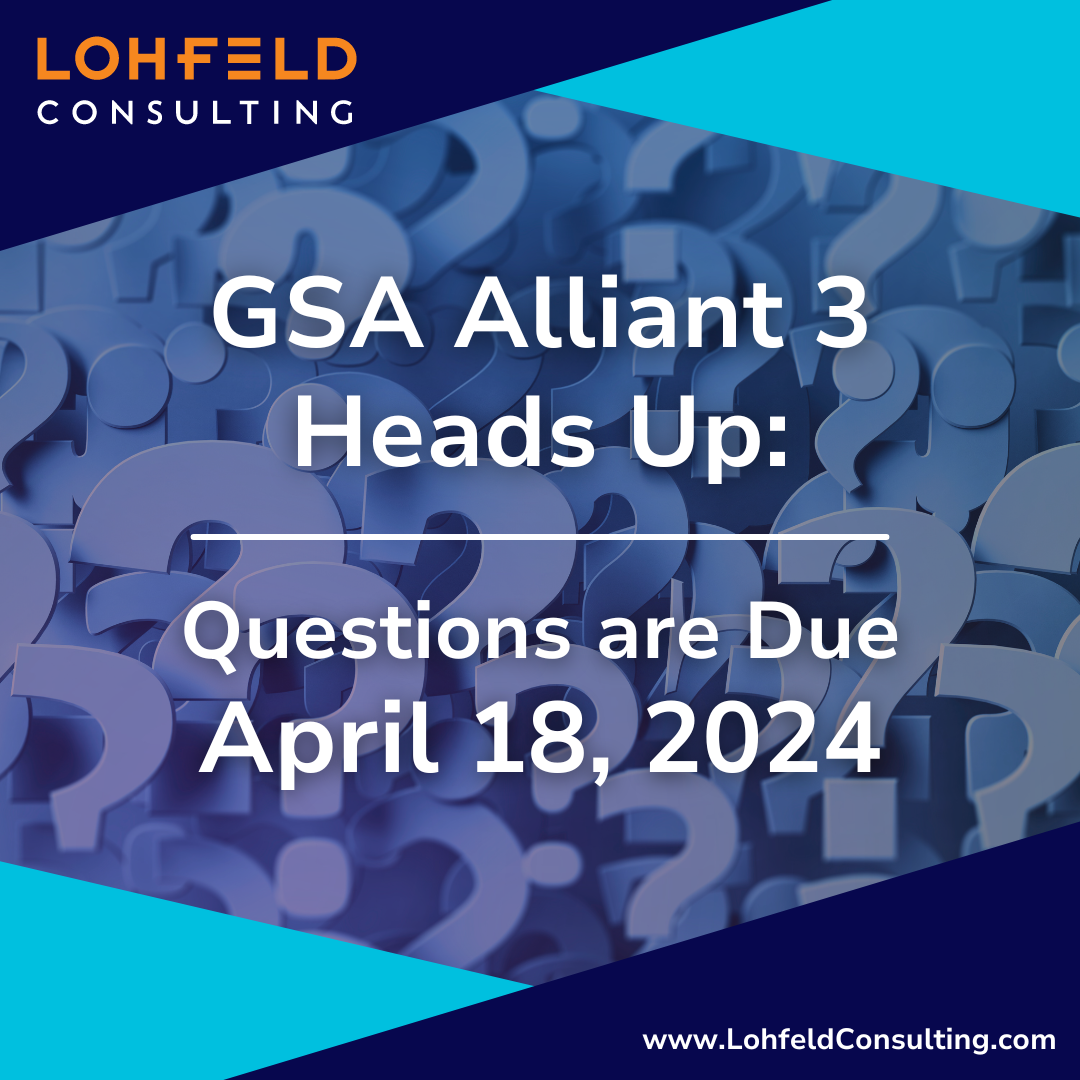Alliant 3 Heads Up: Questions Due April 18

The General Services Administration (GSA) Contracting Office released a pre-solicitation packet with early draft attachments on April 10, 2024. GSA anticipates releasing the final solicitation in Q3 FY2024. GSA requests offerors provide feedback on the draft attachments to alliant3feedback@gsa.gov by no later than Thursday, April 18, 2024. GSA indicated that feedback sent to this email will be reviewed, and any changes based on that feedback will be reflected in the official Alliant 3 RFP solicitation. The government increased the planned number of awards from 60 to 76 (plus ties).
The draft solicitation packet contains seven draft attachments to review. A summary of each document’s highlights and potential risks and challenges to responding to Alliant 3 follows.
Document Highlights
#1: L.5.1.1 Standard Form (SF) 33 and SF-30 for Amendments
Each Offeror must submit only one proposal, either as an individual entity or as part of a Contractor Teaming Arrangement (CTA). Submission of multiple proposals, either directly through affiliated entities or as a member of different CTAs, is prohibited. If multiple submissions occur, a CTA’s parent company or managing partner must select one proposal for submission and withdraw the others. In addition:
SF-33:
- The government requires a minimum acceptance period of 365 calendar days, which must be reflected in the offer.
- Complete the SF-33 and use it to acknowledge all amendments to the solicitation.
- Verify the information in Block 15A of the SF-33 matches the Offeror’s details in SAM.gov, including the Commercial and Government Entity (CAGE) Code, since it is used for official correspondence.
- An individual authorized to commit the Offeror to contractual obligations must sign the SF-33.
Existing JVs, Small Business CTAs, and Meaningful Relationships:
- An existing joint venture (JV) or CTA may submit proposals if it has a Unique Entity Identification (UEI) Number in SAM.gov. Please see the draft solicitation for specific requirements for JVs and CTAs, including the types of arrangements that are allowable and those that are not. Also, the specific requirements for claiming relevant experience and past performance must be reviewed, and clear documentation and evidence of capability must be provided.
- Offerors can claim credit for evaluation elements involving relevant experience, past performance, systems, certifications, and clearances from parent companies, affiliates, divisions, or subsidiaries if there is a meaningful operational relationship. Meaningful Relationship Commitment Letters (MRCLs) must detail how these capabilities are applied to task orders.
- The document outlines specific provisions and alternate sections applicable to small business concerns, including the use of CTAs and mentor-protégé arrangements. It emphasizes the importance of compliance with small business regulations.
#2: Attachment J.P-1 CTA Template (An existing Joint Venture for an Other than Small Business CTA or a Small Business CTA)
This document provides guidelines for offerors bidding on the Alliant 3 Unrestricted Governmentwide Acquisition Contract (GWAC) to claim relevant project experience gained as a member of an existing or previous Contractor Team Arrangement (CTA). This validation is crucial for proposals submitted under the Alliant 3 Unrestricted GWAC, Solicitation No. 47QTCB24R0009. Here are the key points:
- One of the CTA members, other than the Offeror, must sign the form to affirm its authenticity and accuracy. This endorsement certifies that the Offeror was indeed the entity that executed the project work detailed in the form and that no other CTA members can claim credit for this same portion of the project.
- The form allows the Offeror to claim project experience for work performed: 1) as a member of an other-than-small business’s existing or previous JV, or 2) as a part of an existing or previous small business CTA, which could be a Small Business JV, Small Business with Subcontracting, or Small Business Mentor-Protégé arrangement.
- Completing and submitting the form does not necessitate any alterations to existing project documentation or systems related to the awarded CTA project.
- The Offeror must complete Parts I-III of the form, detailing their project experience.
- The information provided must match that in Attachment J.P-2 or J.P-3.
- Once signed, the Offeror should save the document as a PDF file, adhering to the solicitation’s naming convention specified in Section L.4.1, Proposal Format.
This form serves as an essential tool for offerors to substantiate their role and performance in projects undertaken through CTAs, thereby supporting their proposal’s credibility and eligibility under the Alliant 3 Unrestricted GWAC solicitation.
Attachments J.P-2, 3, 4, and 5
These attachments are four-part forms. Part I requires the Offeror to provide basic project identification information. Part II requires Project Reference Information. Part III requires the descriptions summarized below. For all Part II requirements, the Offeror must pinpoint specific sections within the document(s) through Symphony Tagging that substantiate the claim. The response must not exceed 5,000 characters, spaces included. Part IV requires the Offeror to sign the document and verify that the information they provided is accurate.
- #3: Attachment J.P-2 A3. Primary NAICS Code Relevant Experience Project Template: Part III requires a brief project description. The narrative must demonstrate how the project fulfilled the North American Industry Classification System (NAICS) criteria for the claimed score, as delineated in Section L.5.2.3.1 and Section L.5.2.3.2, despite its absence from the Federal Procurement Data System (FPDS). The Offeror must be the prime on the cited reference.
- #4: ATTACHMENT J.P-3 A3. Emerging Technology Relevant Experience Project Template: Part III requires the Offeror to describe how the project used selected Emerging Technology (ET) to perform the project, as specified in Section L.5.2.4.2. The Offeror must be the Prime on the cited reference.
- #4: ATTACHMENT J.P-3. Describe how the selected ET was integral to the project’s performance as specified in Section L.5.2.4.2.
- #5: Attachment J.P-4 A3. Subcontractor Experience Project Template: As delineated in L.5.2.2, Part III requires the Offeror to describe their experience on a project where the Offeror performed as a subcontractor.
- #6: Attachment J.P-5 A3. Small Business Engagement Template: As specified in Section L.5.2.4.4, Part III requires the Offeror to explain the small business’s detailed emerging technology experience on a cited reference.
#7: Attachment J.P-7 A3. Past Performance Rating Template
Attachment J.P-7 is a form the customer must complete to rate the Offeror’s performance. Part 1 of the attachment requires basic project identification information, and Part II requires contact information about the customer conducting the review, as well as contact information for the contracting officer.
The final part of the form asks the customer to rate the Offeror’s quality of service, schedule (timeliness), cost control, management, small business contracting, and regulatory compliance performance. The customer is requested to rate the Offeror’s experience on a six-point scale: exceptional, very good, satisfactory, marginal, unsatisfactory, or not applicable. The customer can also provide additional comments to substantiate their rating.
Challenges and Risks
Ensuring compliance with all aspects, such as the submission format, eligibility criteria, relevant experience, and technical capabilities of Alliant 3, can be challenging. The solicitations may be amended, requiring offerors to stay updated and adjust their proposals accordingly, which can be logistically challenging and increase the risk of non-compliance. The offerors must demonstrate their capability and past performance, as specified in the draft solicitation. Failure to tag substantiating facts can minimize the chances of an award.
Offerors should thoroughly understand the solicitation requirements and craft compliant proposals rich in facts that substantiate their authenticity. They should keep abreast of amendments and updates to the solicitation. Some companies might consider consulting with legal and procurement experts to help navigate the complexities of Alliant 3.
By understanding and preparing for these risks and challenges, offerors can better position themselves to compete for and execute contracts under Alliant 3 successfully.
Related Content:
By Brenda Crist, Vice President at Lohfeld Consulting Group, MPA, CPP APMP Fellow
Lohfeld Consulting Group has proven results specializing in helping companies create winning captures and proposals. As the premier capture and proposal services consulting firm focused exclusively on government markets, we provide expert assistance to government contractors in Capture Planning and Strategy, Proposal Management and Writing, Capture and Proposal Process and Infrastructure, and Training. In the last 3 years, we’ve supported over 550 proposals winning more than $170B for our clients—including the Top 10 government contractors. Lohfeld Consulting Group is your “go-to” capture and proposal source! Start winning by contacting us at www.lohfeld.seablaze.website and join us on LinkedIn, Facebook, and YouTube(TM).
Paperback or Kindle
10 steps to creating high-scoring proposals
by Bob Lohfeld
contributors Edited by Beth Wingate
Subscribe to our free ebrief
Teaming friends, frenemies, and enemies—12 tips to mitigate harmful effects
Did you know that contracting officers spend up to 20% of their time mitigating disputes between teaming partners? In an informal poll we conducted on LinkedIn last month, 40% of respondents classified their teaming partners as “frenemies” on their last bid.
Explore Further
- Advice (489)
- AI (14)
- APMP (17)
- Army MAPS Contracts (2)
- Business Development (226)
- Capture Management (204)
- Complex Technology Grants Services (9)
- Favorite Books (5)
- Go-to-Market (27)
- Graphics (5)
- Lohfeld Books (2)
- NASA SEWP VI Contracts (2)
- Navy SeaPort-NxG Contracts (2)
- NIST MSE Grants (1)
- NIST NAPMP Grants (2)
- Past Performance (59)
- Post-submission Phase (14)
- Pre-RFP Preparation (215)
- Proposal Management (285)
- Proposal Production (64)
- Proposal Reviews (29)
- Proposal Writing (88)
- Pursuit Phase (90)
- Research Report (2)
- Resources (59)
- Tools & Tips (311)
- Training (10)
- Uncategorized (218)

Sign Up for INSIGHTS and Download your FREE book
We'd love to help you with your proposals. Enjoy our complimentary Lohfeld Consulting Group Capture & Proposal Insights & Tips book with your FREE subscription to our Insights Newsletter.
GET YOUR FREE BOOK




